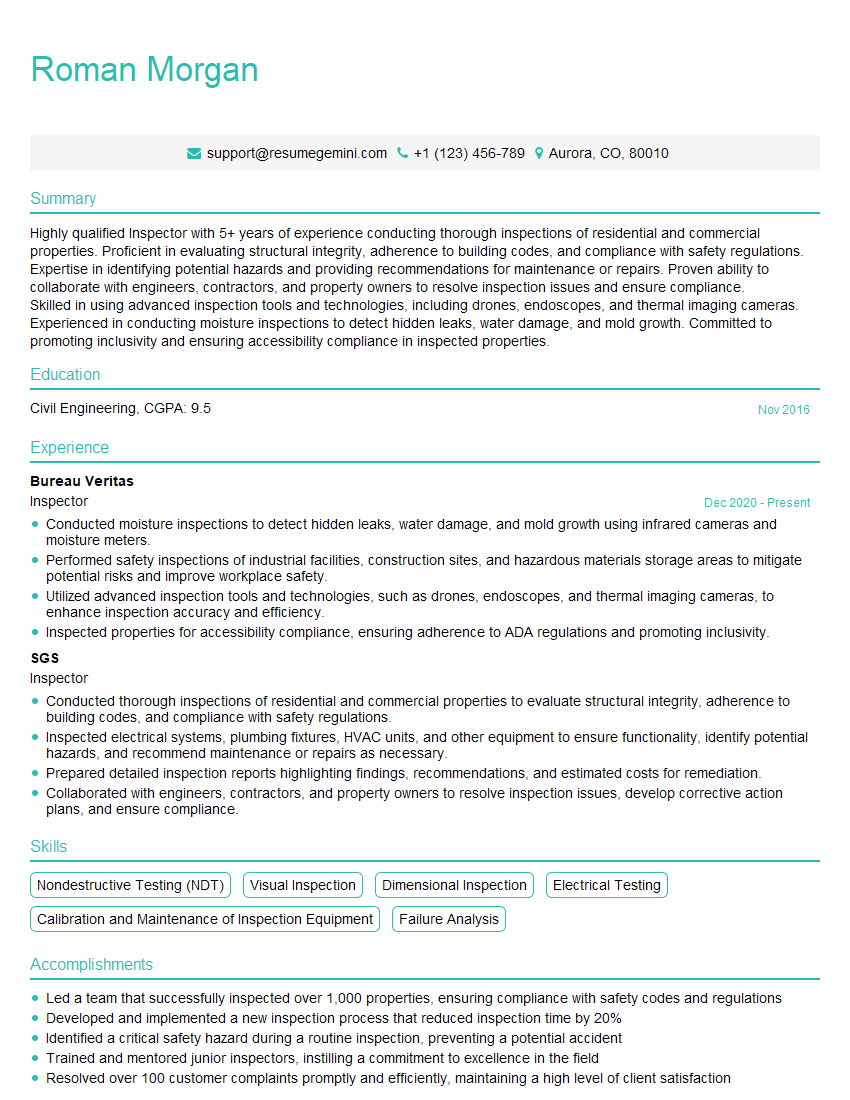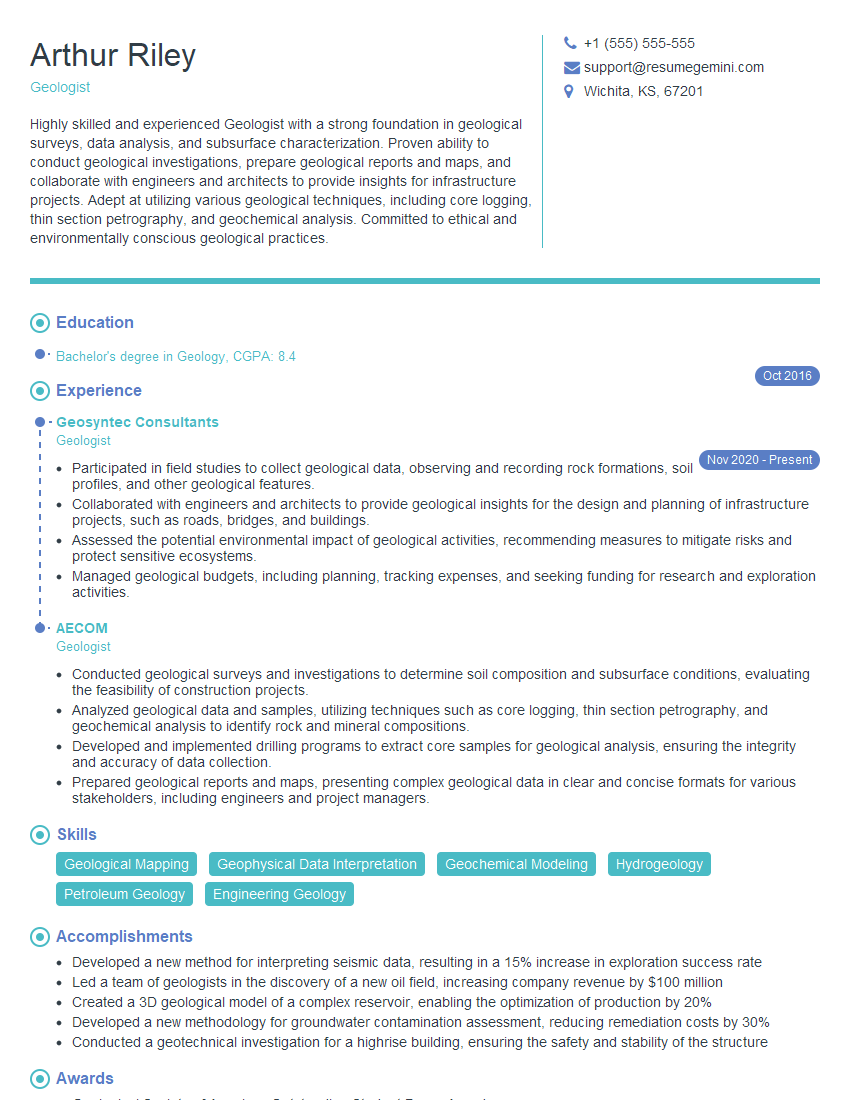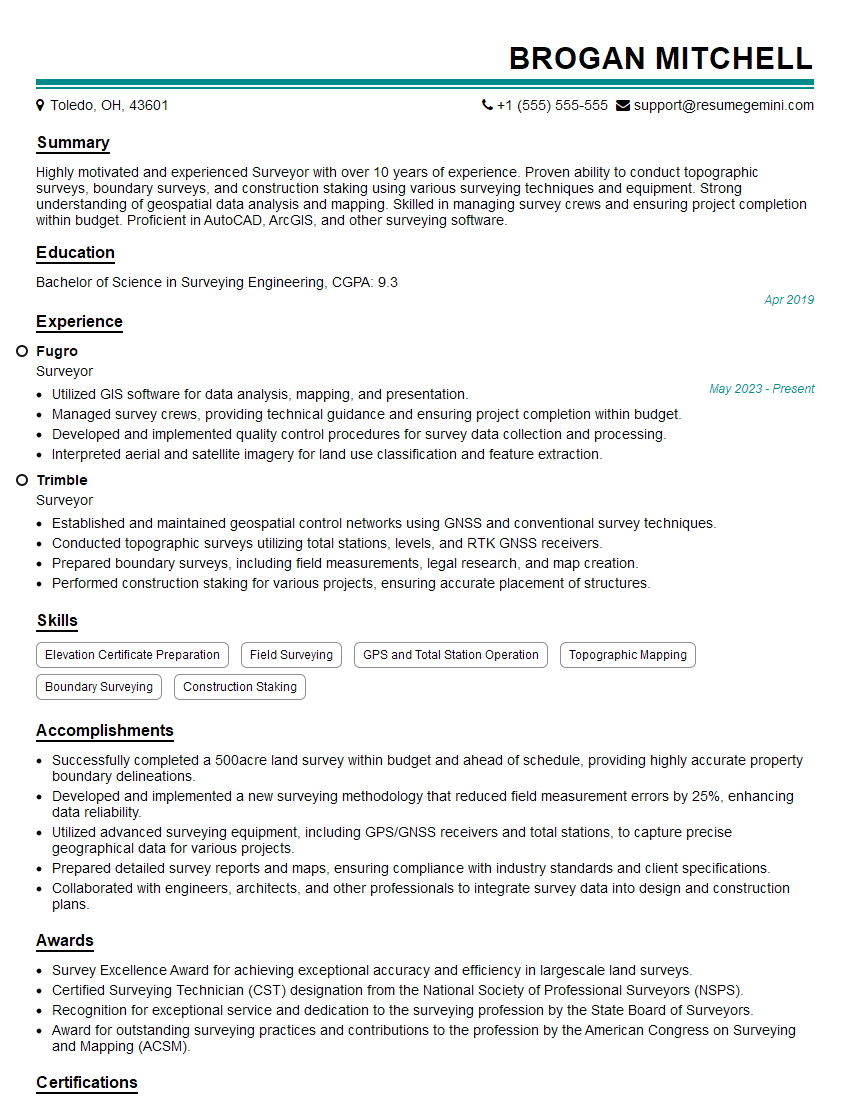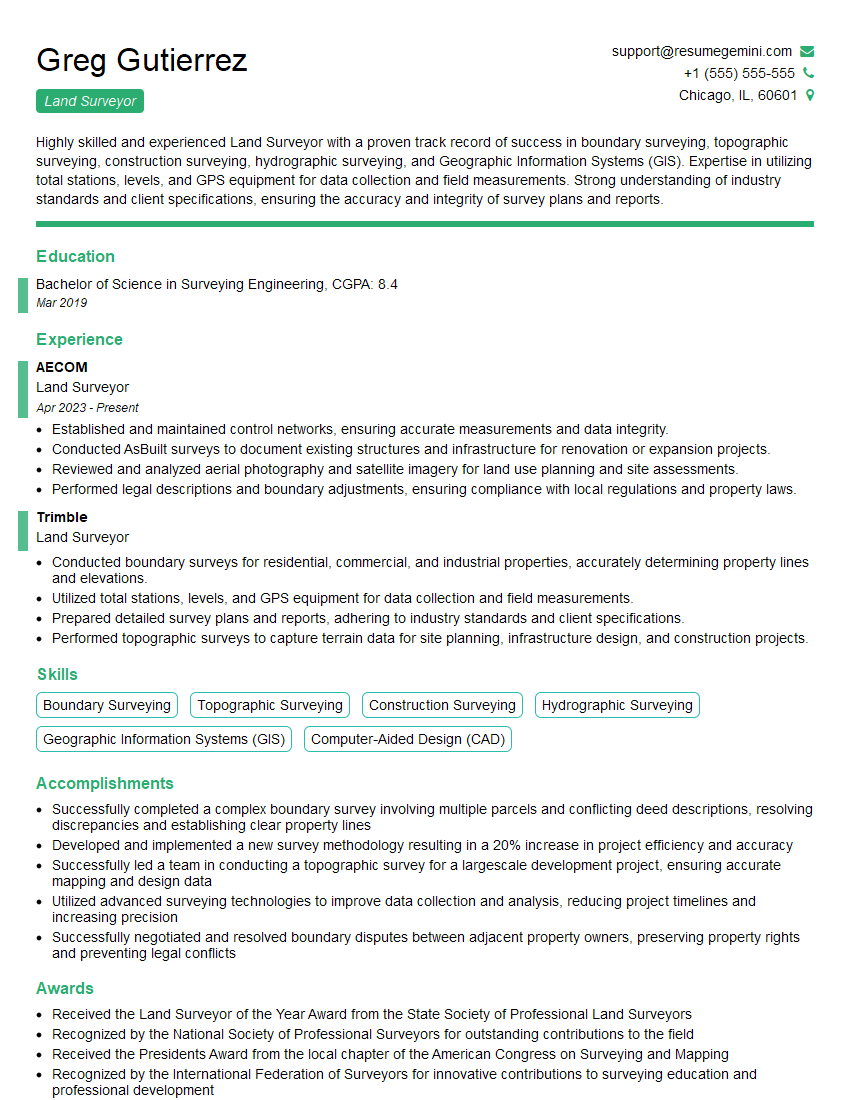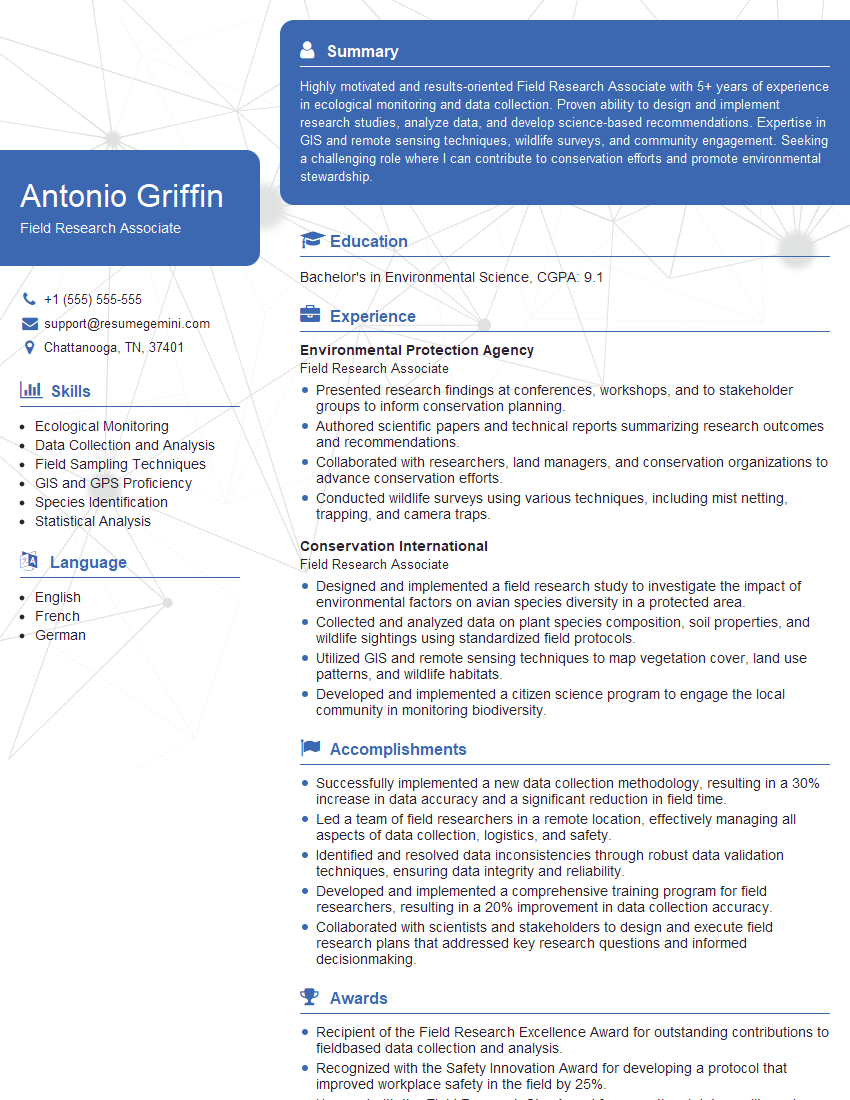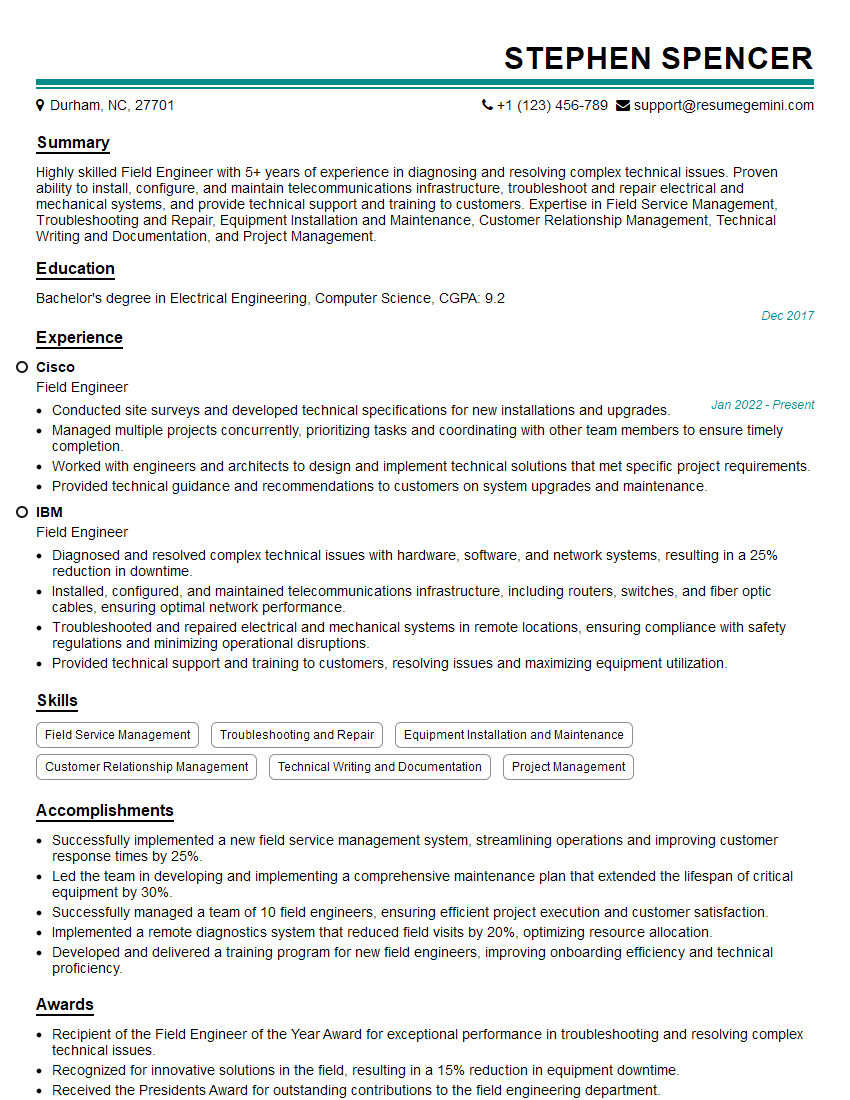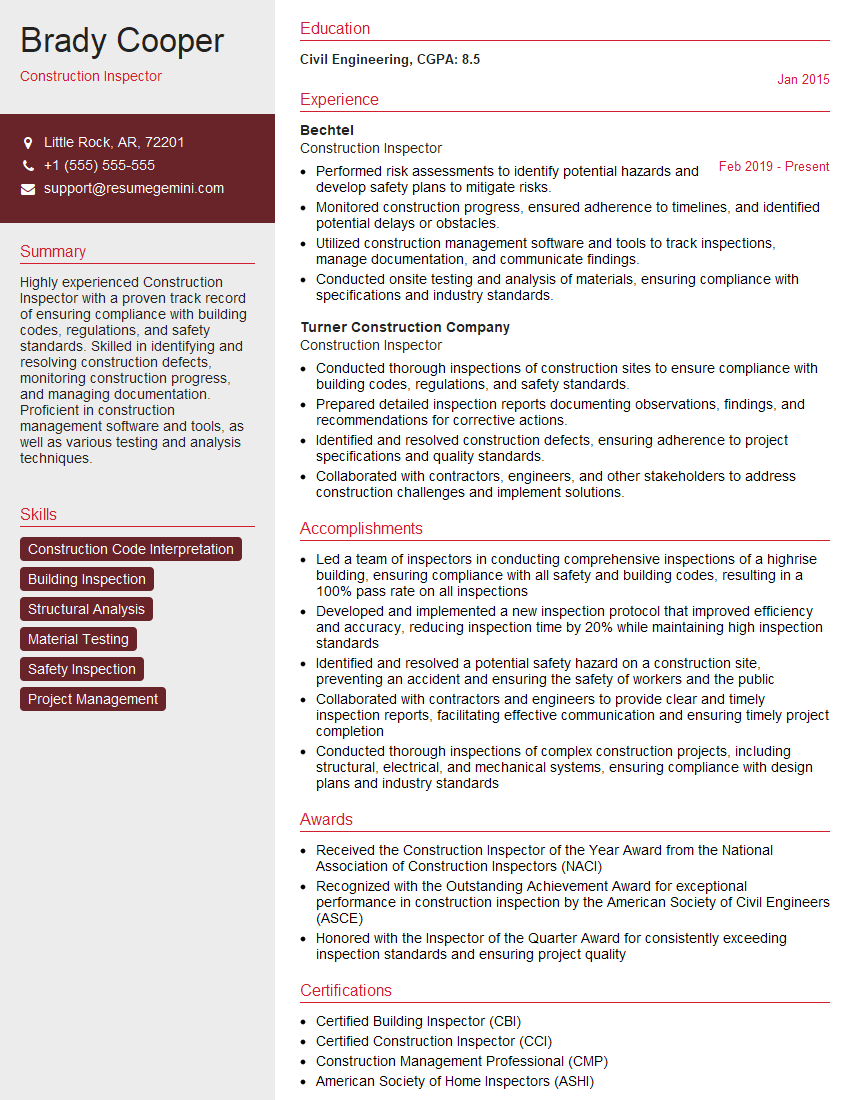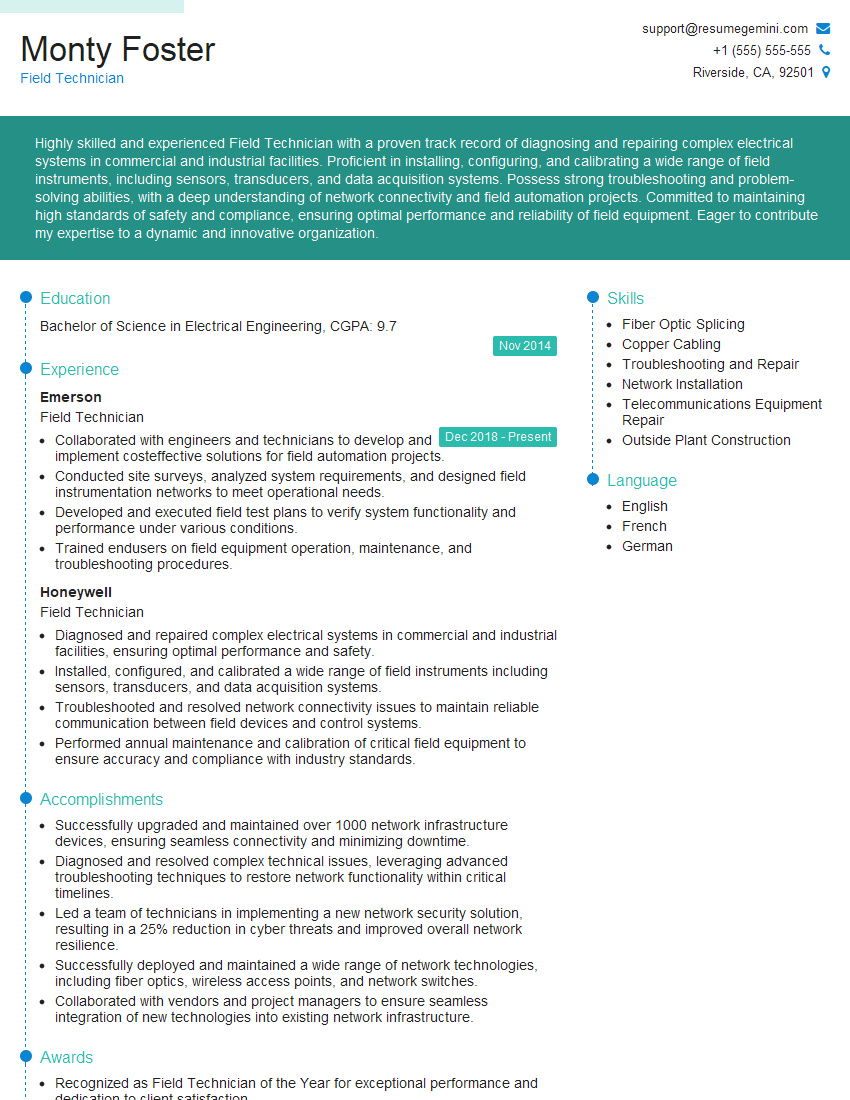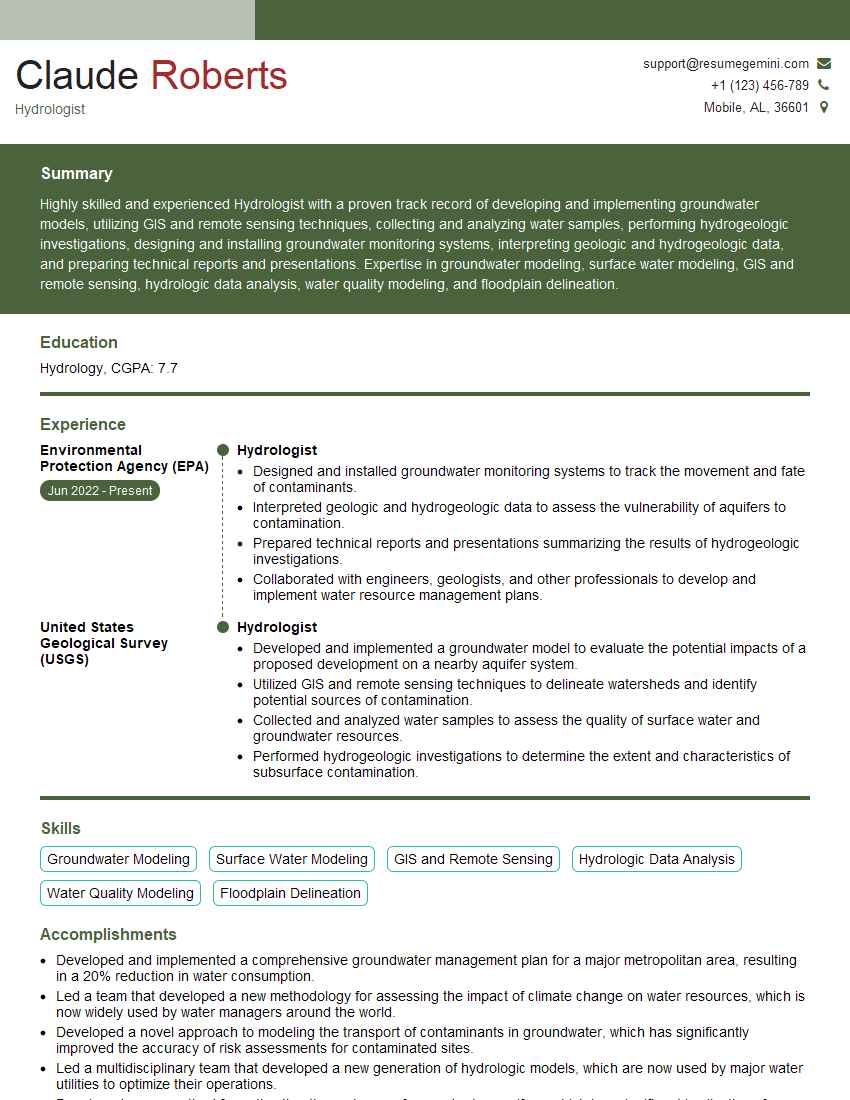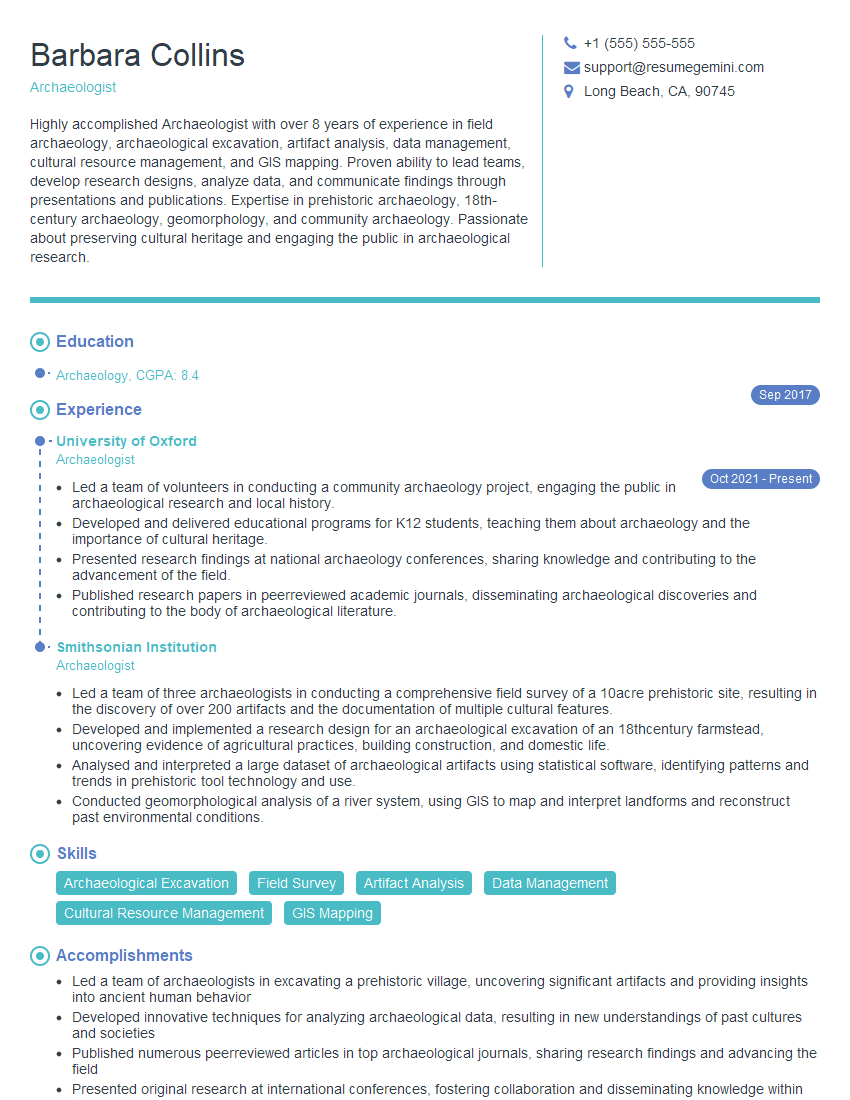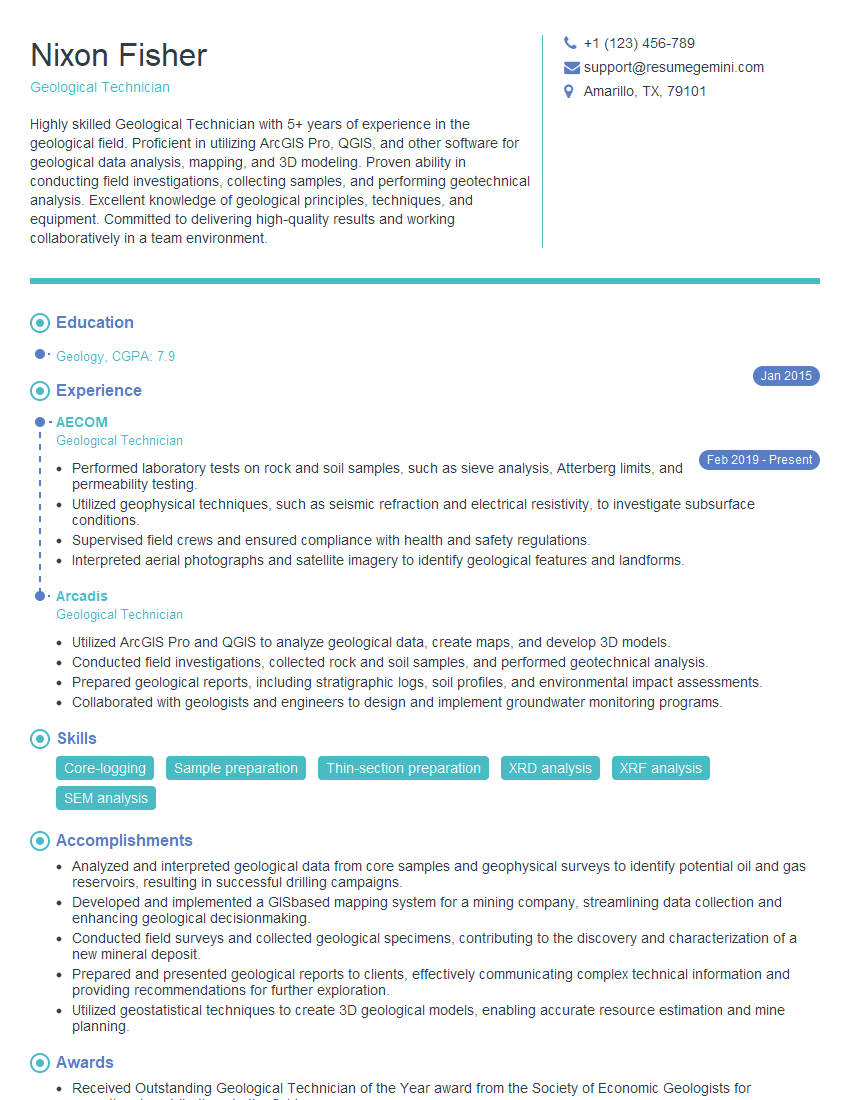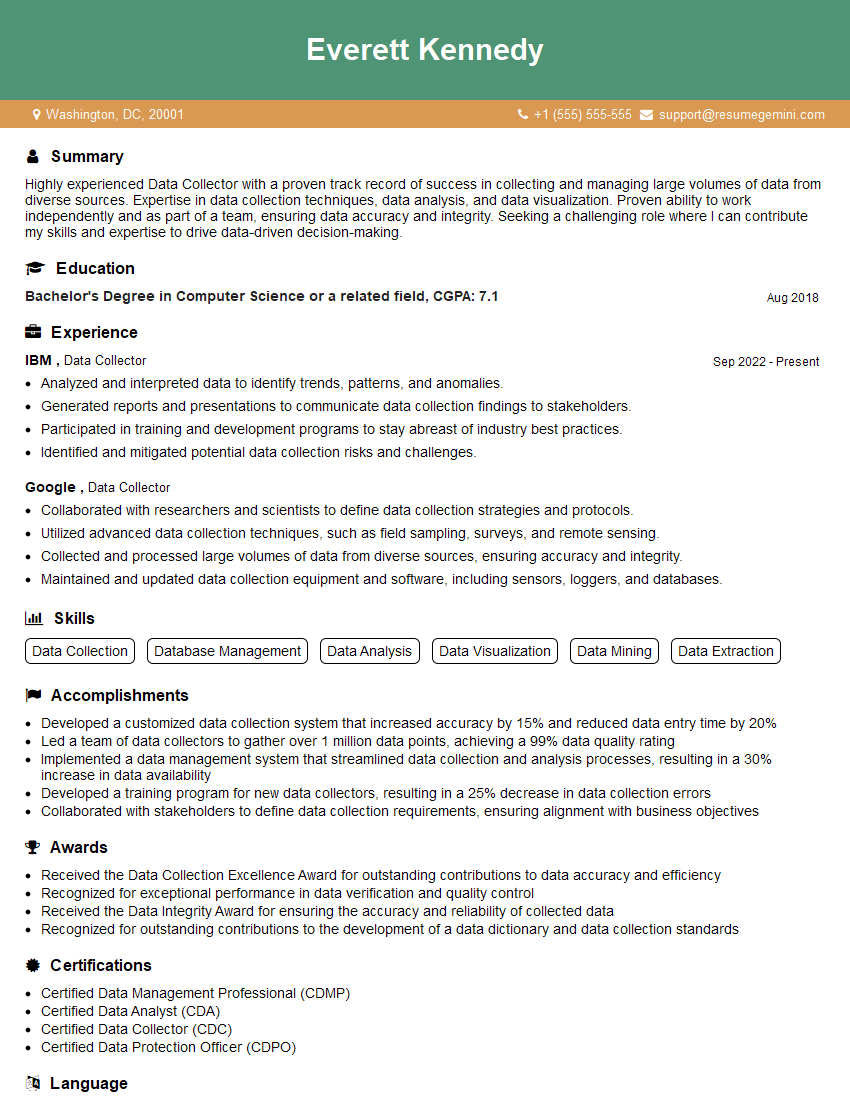Cracking a skill-specific interview, like one for Proficient in using field notebooks and maintaining accurate field records, requires understanding the nuances of the role. In this blog, we present the questions you’re most likely to encounter, along with insights into how to answer them effectively. Let’s ensure you’re ready to make a strong impression.
Questions Asked in Proficient in using field notebooks and maintaining accurate field records Interview
Q 1. Describe your experience with various types of field notebooks.
My experience with field notebooks spans a wide range, from traditional bound paper notebooks to digital solutions. I’ve used waterproof, tear-resistant notebooks for fieldwork in challenging environments like rainforests or construction sites. For projects requiring intricate diagrams or sketches, I’ve favored notebooks with gridded or graph paper. I’ve also incorporated specialized notebooks with pre-printed templates for specific data types, such as soil profiles or geological cross-sections. More recently, I’ve begun using tablet-based digital notebooks, which offer advantages in terms of data organization, searchability, and ease of sharing. The choice of notebook always depends on the project’s specific requirements and the environment.
- Traditional Bound Notebooks: Ideal for quick notes, sketches, and situations with limited technology.
- Waterproof/Durable Notebooks: Essential for fieldwork in harsh weather or rugged terrain.
- Gridded/Graph Paper Notebooks: Perfect for precise diagrams, maps, and detailed sketches.
- Specialized Notebooks (pre-printed): Streamline data collection for specific tasks and enhance organization.
- Digital Notebooks (Tablets): Offer advantages in organization, searchability, and data sharing.
Q 2. How do you ensure the legibility of your field notes?
Legibility is paramount in field note-taking. I use a consistent, clear, and concise writing style, ensuring my handwriting is large enough to read easily later. I avoid ambiguity by using standard abbreviations and symbols, always defining them in a key at the beginning of each notebook or section. I utilize different colored pens or pencils to highlight important observations or differentiate data types. For example, I might use blue ink for measurements and red ink for critical observations. I also ensure my notes are properly spaced and organized to prevent confusion. If my handwriting isn’t clear in a particular instance, I’ll immediately make a note to clarify it later using a digital recorder or camera, adding timestamp and location details.
Q 3. What methods do you use to maintain the organization of your field notebooks?
Organization is crucial for efficient data retrieval. I use a consistent numbering system for pages and sections, and I create a detailed table of contents at the beginning of each notebook or digital file. I date and time-stamp each entry, which is vital for traceability. I use headings and subheadings to clearly delineate different aspects of the field work. I often group related data points together, for example, all soil sample data from one location would be grouped under a single heading. Furthermore, I maintain a color-coded system to aid rapid visual identification. For digital notebooks, I utilize folders and tags to improve organization and maintain a logical structure.
For instance, a project on wetland vegetation might have sections on ‘Site Location,’ ‘Vegetation Surveys,’ ‘Water Quality Data,’ and each will have clear headings and subheadings for specific measurements.
Q 4. Explain your process for accurately recording timestamps and locations in the field.
Accurate timestamps and locations are fundamental to ensuring data integrity. I use a high-precision GPS device to record coordinates and synchronize it with my field notebook, both physical and digital. For digital notebooks, the GPS data is automatically embedded with the entry. I record the time using a reliable watch or my phone, synchronizing it with the device time. For time-sensitive observations, I record the time to the nearest second. I also use a clear and consistent format for recording time and location, for example: YYYY-MM-DD HH:MM:SS, Latitude: xx.xxxxx, Longitude: yy.yyyyy. Each entry is clearly linked to its respective geographical location. To double-check the accuracy, especially in remote areas, I occasionally use multiple devices to cross-reference the location data.
Q 5. How do you handle corrections or errors in your field notes?
I never erase or obliterate errors in my field notes. Instead, I use a single line to strike through the incorrect information and then write the correct information beside it. I then clearly indicate the correction with an annotation such as ‘Corrected from…’ or ‘Amendment:’. This process preserves the original data for traceability and maintains the integrity of the record. This is vital for auditing and quality control. This method clearly shows the evolution of understanding or measurement and ensures the full record is preserved. In digital notebooks, a similar approach is used, either by strikethrough or by version control, maintaining a history of changes.
Q 6. What systems do you employ to prevent data loss in the field?
Preventing data loss is crucial. For paper notebooks, I carry multiple notebooks to account for unexpected events like damage or loss. I keep a backup set of digital copies of critical information. I also regularly photograph my field notes at the end of each day, preserving them in a cloud storage system. For digital notebooks, I leverage cloud syncing services to automatically back up my work to multiple locations. I also employ data redundancy measures, creating backups on external hard drives and utilizing version control systems wherever possible. For sensitive data, I use encryption to protect it during storage and transmission. Regular checks of data integrity and functional tests of my data storage systems are vital parts of my workflow.
Q 7. Describe your approach to data backup and security for field records.
Data backup and security are paramount. My approach involves a multi-layered strategy. For physical notebooks, high-resolution scans are stored in encrypted cloud storage (e.g., Google Drive or Dropbox) with regular backups to an external hard drive. For digital notebooks, I use cloud storage services with version control, ensuring regular backups and data redundancy. I employ strong passwords and two-factor authentication for all accounts. Data is encrypted both during transit and at rest. I regularly review my security settings and update software to patch vulnerabilities. Access to my field data is controlled through user permissions. Access is limited to authorized personnel only, following best practices for data protection compliance. Finally, I maintain a detailed audit trail of all data access and modification. I adhere to all relevant data privacy regulations and policies.
Q 8. How do you ensure the accuracy and completeness of your field data?
Ensuring accurate and complete field data is paramount. My approach is multifaceted and begins with meticulous planning. Before any fieldwork, I define clear objectives, develop a standardized data collection protocol, and select appropriate tools. This includes pre-printed forms with clearly labeled fields to minimize ambiguity. During data collection, I employ several checks and balances. For instance, I always double-check measurements, and I use redundancy – recording data in multiple ways (e.g., written notes and digital photographs). I immediately flag any inconsistencies or anomalies, noting them in my field notebook with a detailed description and potential causes. After fieldwork, I conduct a thorough review of all my data, checking for completeness and logical consistency. For example, if I’m tracking bird species, I cross-reference my observations with established field guides to validate identifications.
Think of it like baking a cake; each ingredient and step must be precise. Ignoring a minor detail can ruin the whole cake. Similarly, neglecting a small detail in field data can invalidate an entire dataset.
Q 9. How do you differentiate between qualitative and quantitative data in your field notes?
Qualitative data describes qualities or characteristics, while quantitative data involves numerical measurements. In my field notes, I clearly distinguish between them using specific formatting and terminology. For example, qualitative data like descriptions of soil texture (‘silty loam’, ‘clayey’) or observations on animal behavior (‘aggressive’, ‘passive’) are written descriptively. Quantitative data, such as temperature readings (25°C), GPS coordinates (34.0522° N, 118.2437° W), or the number of plant species (15), are presented with numerical values and units. I frequently use tables to organize quantitative data, making it easier to analyze later. For instance, I might create a table listing different plant species, their counts, and location coordinates. This organized approach ensures clarity and facilitates efficient data analysis.
Q 10. How do you integrate data from different sources into your field records?
Integrating data from different sources is a crucial aspect of comprehensive field studies. I often incorporate data from GPS devices, weather stations, remote sensing imagery (satellite or drone), and laboratory analyses into my field records. To maintain consistency, I employ a standardized data entry format, typically creating tables or spreadsheets. Each data point is meticulously labeled with its source and date/time stamp. For example, I might have a table with columns for GPS coordinates (from my GPS device), soil pH (from a soil testing kit), and vegetation cover percentage (from a drone survey). I carefully cross-reference information, looking for any discrepancies that need further investigation. This integrated approach offers a more holistic understanding of the study area and strengthens the validity of findings. A comprehensive record ensures reproducibility and transparency.
Q 11. Describe your experience using specific software for data entry or analysis from field notebooks.
I’m proficient in several software packages for data management and analysis. For example, I regularly use ArcGIS for geospatial data management and analysis. I input GPS coordinates and other spatial data from my field notebook into ArcGIS to create maps and conduct spatial analyses. I also utilize Excel extensively for data entry, organization, and basic statistical analysis. I find it particularly useful for creating organized tables of quantitative data directly from my field notebooks. For more complex statistical analysis, I utilize R. Specifically, I’ve used R packages like ggplot2 for data visualization and statistical analysis packages for more advanced modeling.
Q 12. Explain how you ensure compliance with relevant regulations when recording field data.
Compliance with regulations is paramount in field work. My procedures always adhere to relevant environmental regulations, health and safety guidelines, and ethical considerations. For example, if I’m working on endangered species, I strictly adhere to permit requirements, making sure every observation is documented according to these permits, including dates, locations, and specific details of the observation. In my field notes, I clearly document the protocols followed, the equipment used, and any relevant permits or approvals. This meticulous record-keeping provides evidence of compliance and facilitates auditing. Maintaining this level of transparency is essential for building trust and credibility.
Q 13. How do you manage field notes during inclement weather or challenging conditions?
Inclement weather or challenging conditions necessitate proactive measures. I always carry waterproof field notebooks and pens, and I use protective cases for electronic devices. If conditions become unsafe, I prioritize safety and postpone fieldwork. In challenging situations, I might use voice recording to document observations temporarily, later transcribing these notes into my field notebook under more favorable conditions. I always make sure to clearly note the date, time, and conditions impacting the data collection in my notes. For example, if heavy rain affected visibility, I would note this and estimate the extent of the impact on my observations. This transparency is critical for data interpretation.
Q 14. How do you transfer field notes into digital formats?
Transferring field notes into digital formats is essential for data sharing and long-term preservation. I typically use a combination of methods. For handwritten notes, I scan them using a high-resolution scanner, maintaining the original quality. I also use digital photography extensively. I capture images of noteworthy observations, specimens, or field setups. These images supplement my written descriptions. I store digital files in a well-organized folder structure, following a consistent naming convention to ensure efficient retrieval. Depending on the data type, I import the digitized data (text, images, tabular data) into relevant software, like ArcGIS or Excel, for further analysis and management. Regular backups are crucial to prevent data loss.
Q 15. What quality control measures do you implement when reviewing field notes?
Quality control in field note review is paramount for data integrity. My approach involves a multi-step process. First, I perform a thorough initial review for completeness and legibility – ensuring all data points are present and easily decipherable. Then, I check for consistency within the notes themselves. For example, if I’m recording plant heights, I verify that the units (e.g., centimeters) remain consistent throughout. Finally, I compare the data to my initial expectations or hypotheses, identifying any outliers that need further investigation. This could involve returning to the field site to re-measure a specific plant or re-checking my equipment calibration.
Example: During a soil sampling project, I noticed a soil pH reading significantly different from surrounding samples. My quality control process flagged this, leading me to review my methodology and ultimately discover a calibration issue with my pH meter.
Career Expert Tips:
- Ace those interviews! Prepare effectively by reviewing the Top 50 Most Common Interview Questions on ResumeGemini.
- Navigate your job search with confidence! Explore a wide range of Career Tips on ResumeGemini. Learn about common challenges and recommendations to overcome them.
- Craft the perfect resume! Master the Art of Resume Writing with ResumeGemini’s guide. Showcase your unique qualifications and achievements effectively.
- Don’t miss out on holiday savings! Build your dream resume with ResumeGemini’s ATS optimized templates.
Q 16. How do you handle incomplete or ambiguous data entries in your field records?
Handling incomplete or ambiguous data is crucial to avoid misinterpretations. My strategy begins with attempting to resolve the ambiguity. This might involve consulting field photographs, GPS coordinates (if recorded), or my field notes from previous or subsequent days to find contextual clues. If I cannot resolve the ambiguity after careful review, I clearly document the issue, indicating precisely what information is missing and the attempts made to recover it. I flag this incomplete data in my final report to maintain transparency and avoid misrepresenting the dataset. Data that cannot be resolved is typically excluded from quantitative analysis, but its existence and limitations are explicitly acknowledged.
Example: If a weather data point is missing, I wouldn’t simply fill it with an average. I’d indicate the missing data point and note that weather conditions on that day are not represented accurately in the analysis.
Q 17. Describe your process for reviewing and verifying data before submitting it.
My data verification process is rigorous and follows a clear sequence. After completing field data entry, I conduct a thorough self-review, comparing the raw data with my field notes, identifying any inconsistencies. Next, I use data validation tools (where applicable) – like spreadsheets with error-checking formulas – to identify any errors arising from data entry. Finally, I cross-reference the data with any available secondary data sources (e.g., satellite imagery, existing maps, lab results) wherever feasible. This cross-validation helps confirm the accuracy of my collected data and flags any unusual patterns requiring further exploration.
Example: When surveying land use changes, I would compare my field observations of deforestation with satellite images from the same period to ensure consistency. Any significant deviations would trigger a closer examination.
Q 18. How do you handle discrepancies between field notes and other data sources?
Discrepancies between field notes and other data sources necessitate careful investigation. I start by carefully comparing the data sets, noting the specific differences and their magnitude. Then, I systematically investigate potential sources of error: inaccuracies in data entry, errors in measurement tools, differences in spatial or temporal resolution between data sets, or variations inherent in the nature of the data. After identifying the likely source of the discrepancy, I document the findings and, if possible, adjust the data accordingly. If the source of the discrepancy remains unresolved, I detail the conflict and its potential implications in my final report.
Example: A discrepancy between a manually measured tree diameter and a diameter derived from aerial imagery might be attributed to differences in resolution or measurement techniques; this would be fully documented in my report.
Q 19. What is your experience with different data entry methods (e.g., handwritten, digital)?
I have extensive experience with both handwritten and digital data entry methods. Handwritten notes are still valuable for quick sketches, observations, and initial data recording, especially in areas with limited connectivity. They allow for free-form recording and quick capture of immediate observations. However, for large datasets, I prefer digital methods. Using tablets or dedicated data loggers significantly improves data quality control through features like automated error checks, data validation, and easy data transfer to analysis software. I’m proficient in various data entry software and understand the importance of data standardization for both methods. My preference depends on the specific project demands and logistical constraints.
Example: In a remote location with no internet, I might use a handwritten notebook and then later transfer the data into a digital format, possibly using a GIS system.
Q 20. How familiar are you with GPS technology and its integration into field data recording?
I am highly proficient with GPS technology and its integration into field data recording. I routinely use GPS receivers and mapping software to record precise locations of observations. This ensures accurate geospatial referencing, crucial for many field studies. I understand different GPS accuracy levels and select the appropriate device for the project’s requirements. I also know how to account for potential GPS errors, such as signal interference and multipath effects. Integrating GPS data with other field observations (e.g., species identification, soil type, or environmental measurements) creates a richer and more contextually informative dataset.
Example: When mapping wetland vegetation, I’d use a high-accuracy GPS to precisely locate the boundaries of different vegetation types, ensuring accurate mapping of the wetland ecosystem.
Q 21. How do you organize your field notes to facilitate future analysis and reporting?
Organizing field notes for future analysis and reporting is critical for efficient data management. My organizational approach incorporates several key elements: a consistent naming convention for files and folders, a well-defined structure within the field notebook (e.g., sections for observations, measurements, sketches, and GPS coordinates), and a comprehensive index. Using digital data entry allows for easy searching and filtering. I also utilize metadata tagging to further categorize and annotate data points. For larger projects, I organize data using a database system or GIS, which enables robust searching, querying, and spatial analysis.
Example: I might use a folder structure like ‘Project Name/Year/Month/Day/Site ID’ for organizing digital field data. Using standardized headers and metadata in spreadsheets greatly assists in later analysis.
Q 22. How do you ensure your field notebooks are easily searchable and retrievable?
Maintaining easily searchable and retrievable field notebooks is crucial for efficient data management. My approach involves a multi-pronged strategy focusing on consistent formatting, comprehensive indexing, and utilizing digital backups.
- Consistent Formatting: I use a standardized format for each entry, including a unique date and time stamp, location coordinates (latitude and longitude), project code, and a concise descriptive title for each observation. For example, each entry might begin with
[2024-10-27 10:30 UTC, Project Alpha, Site 3, Soil Sample Analysis]. This allows for quick filtering and sorting. - Comprehensive Indexing: I create both a detailed index within the notebook itself and a separate digital index (using a spreadsheet or database software) that cross-references page numbers with keywords and topics. This enables rapid retrieval of specific information, even if I only vaguely remember the details of a particular entry.
- Digital Backups: I regularly scan or photograph each page of my field notebooks and store these digital copies securely in cloud storage with version control. This protects against physical loss or damage and also facilitates easy searching using text recognition software.
This combined approach guarantees that my field data is not only meticulously recorded but also easily accessible when needed, saving considerable time and effort during data analysis.
Q 23. Explain your experience with creating and maintaining a field data log.
Creating and maintaining a field data log is essential for organizing raw observations into a structured format. My experience involves developing logs tailored to the specific project needs.
For instance, during a recent ecological survey, my log included columns for date, time, location (using GPS coordinates), species observed, abundance, behavioral notes, weather conditions, and any relevant photographs or sample IDs. I often use spreadsheet software (like Excel or Google Sheets) to create these logs because of their flexibility and data-sorting capabilities. A well-designed log helps ensure data integrity and allows for efficient data analysis later. I always ensure the log has clear headers, units of measurement are specified, and data entry is consistent to minimize errors.
Q 24. What types of data do you typically collect in the field?
The types of data I collect in the field vary considerably depending on the project, but generally include:
- Environmental Data: This includes temperature, humidity, precipitation, wind speed, solar radiation, water quality parameters (pH, dissolved oxygen, turbidity), and soil properties (moisture content, texture, pH).
- Biological Data: This may involve species identification, abundance counts, behavioral observations, sample collection (plants, soil, water, insects), and measurements of organism size or other characteristics.
- Geological Data: This could include rock type identification, stratigraphic descriptions, structural measurements, and sample collection for laboratory analysis.
- Geographic Data: Precise location data using GPS is critical, along with topographic features, land use details, and habitat descriptions.
- Photographic and Video Data: These provide visual records that can complement quantitative measurements.
Additionally, I always record any relevant contextual information, such as equipment malfunctions, unexpected events, or any limitations in data collection. This ensures complete and accurate data recording.
Q 25. How do you prioritize data collection to meet project deadlines?
Prioritizing data collection to meet project deadlines requires a structured approach. My strategy involves:
- Defining Objectives: Clearly understanding the project’s goals and deliverables is the first step. This helps to identify the most critical data points that need to be collected.
- Task Breakdown: Breaking down the data collection process into smaller, manageable tasks allows for efficient prioritization. I often use project management tools to schedule tasks and track progress.
- Time Allocation: I allocate specific time slots for each task, considering potential delays or unexpected events. Flexibility is crucial, but having a plan helps maintain focus.
- Data Validation: Regularly validating the collected data helps identify any gaps or inconsistencies, allowing for timely adjustments to the data collection strategy.
- Collaboration: If working in a team, effective communication and collaboration are essential to ensure that tasks are completed efficiently and in a coordinated manner.
By implementing these steps, I can ensure efficient data collection while meeting project deadlines without sacrificing data quality.
Q 26. How do you adapt your field notebooking techniques to different environments?
Adapting field notebooking techniques to different environments necessitates flexibility and preparedness. My approach emphasizes:
- Weather Protection: Using waterproof notebooks and pens is essential in rainy or humid environments. In extreme temperatures, I might opt for a durable field tablet with a stylus for data entry.
- Terrain Considerations: In challenging terrains, I opt for smaller, lightweight notebooks that are easier to carry. I might also use a voice recorder to supplement written notes, especially when hands are occupied.
- Safety Precautions: In remote or hazardous environments, safety is paramount. I ensure I have appropriate safety gear and share my location with colleagues or emergency contacts.
- Data Storage: I always have backup options for data storage in case of unforeseen circumstances, such as using a cloud storage service or a separate physical copy of the notebook.
- Technology Integration: I utilize appropriate technology for different environments. For example, using GPS devices for precise location data or drones for aerial photography in remote or large areas.
Ultimately, adaptability and a preparedness mindset ensure I can effectively collect high-quality data regardless of the environment.
Q 27. Describe your experience with using specialized equipment or instruments for data collection.
My experience with specialized equipment includes using various instruments for data collection.
For example, I’ve used:
- GPS receivers: for precise location mapping and georeferencing of samples.
- Water quality meters: to measure parameters like pH, dissolved oxygen, and conductivity.
- Soil testing kits: for analyzing soil properties such as pH, moisture content, and nutrient levels.
- Spectrometers: for measuring light absorbance or reflectance, useful in plant physiology studies.
- Total Stations and Theodolites: for precise topographic surveying.
Proficiency in using these instruments involves understanding their operational principles, calibration procedures, and data interpretation. Accurate data collection requires careful attention to detail, proper calibration, and recording of instrument settings. I also maintain detailed records of equipment maintenance and calibration schedules.
Q 28. How do you ensure the confidentiality and integrity of sensitive data collected in the field?
Ensuring confidentiality and integrity of sensitive data is paramount. My approach involves:
- Data Encryption: I encrypt all digital copies of field notebooks and data logs using robust encryption software.
- Access Control: I limit access to sensitive data only to authorized personnel using password protection and secure file-sharing systems.
- Secure Storage: Physical notebooks are kept under lock and key when not in use, and digital data is stored on secure cloud servers with appropriate access controls.
- Data Anonymization: Whenever possible, I anonymize data to protect the privacy of individuals or sensitive locations. This might involve removing identifying information or using codes instead of names.
- Data Backup and Version Control: Regular backups to prevent data loss, combined with version control, helps to safeguard data integrity and prevent accidental deletion.
- Compliance with Regulations: I adhere strictly to all relevant data privacy regulations and institutional guidelines.
By implementing these measures, I ensure that sensitive data remains confidential, secure, and its integrity is maintained throughout the entire data lifecycle.
Key Topics to Learn for Proficient in using field notebooks and maintaining accurate field records Interview
- Data Collection Techniques: Understanding various methods for recording field data, including sketches, diagrams, photographs, and digital recordings. Consider the pros and cons of each method and best practices for each.
- Organization and Structure: Mastering effective notebook organization, including using consistent numbering systems, clear labeling, and indexing. Explore different methods for creating a logical flow of information within your field notes.
- Data Accuracy and Validation: Implementing techniques to ensure data accuracy, such as double-checking measurements, using appropriate units, and noting potential sources of error. Discuss strategies for verifying the reliability of collected data.
- Record Keeping Best Practices: Adhering to industry standards and company protocols for maintaining field records. This includes understanding requirements for data security, confidentiality, and data retention policies.
- Data Transfer and Integration: Learn how to effectively transfer data from field notebooks into digital formats, databases, or reports. Discuss the importance of maintaining data integrity during this process.
- Problem-Solving in the Field: Develop strategies for handling unexpected challenges or inconsistencies in data collection. This includes techniques for troubleshooting equipment malfunctions and adapting to changing field conditions.
- Legal and Ethical Considerations: Understanding the importance of complying with relevant regulations and ethical guidelines when collecting and recording data in the field.
Next Steps
Proficiency in using field notebooks and maintaining accurate field records is crucial for success in many fields, demonstrating attention to detail, organizational skills, and commitment to data integrity. These skills significantly enhance your credibility and demonstrate a commitment to quality work, boosting your career prospects. To increase your chances of landing your dream job, it’s vital to present your skills effectively. Creating an ATS-friendly resume is paramount. ResumeGemini is a trusted resource that can help you build a professional resume tailored to highlight your abilities. Examples of resumes tailored to showcase proficiency in using field notebooks and maintaining accurate field records are available to help you get started.
Explore more articles
Users Rating of Our Blogs
Share Your Experience
We value your feedback! Please rate our content and share your thoughts (optional).
What Readers Say About Our Blog
Hi, I’m Jay, we have a few potential clients that are interested in your services, thought you might be a good fit. I’d love to talk about the details, when do you have time to talk?
Best,
Jay
Founder | CEO

